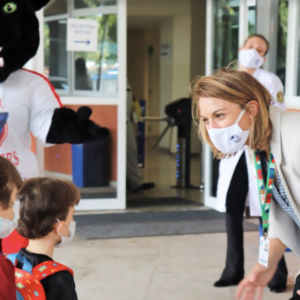Creating a Positive School Culture

What type of school culture or school environment do we want at EARJ? I care about this as a principal because the culture or environment of a school can have an impact on the well-being of students, faculty, staff, and parents.
Many years ago I coordinated a program in a large school district in Washington state. My job included visiting many of the district’s schools on a regular basis. A number of the schools had the same architectural design, including layout and floor plan. But regardless of the almost identical nature of one school building to the next, the difference in school culture and environment I felt by walking through the doors of one school as opposed to another was palpable. In some cases, a school felt warm or welcoming or positive or even joyful, while in other cases walking into another school could feel ominous or sterile or chaotic or just depressing. Every school has a culture and environment, whether the school is intentional about this or not.
Thousands of schools around the world have drawn upon research and practices that grew out of the business context to create the culture and environment they wanted. Marcus Buckingham, in his classic book, First, Break All the Rules: What the World’s Greatest Managers Do Differently, drew upon interviews from more than 80,000 managers and more than one million employees. Among the top 10-12 characteristics he found for a positive and engaging workplace environment were such things as: employees knew what was expected, received recognition each week for good work, had a supervisor who cared and paid attention, received encouragement to contribute and improve, could identify someone at work who is a “best friend”, saw people around them committed to doing a good job, felt they were learning new things and getting better at what they did, and they had the opportunity to do their job well.
Now go back through that same list above, but instead of thinking about managers and employees, think about teachers and students. A positive school culture and environment is created when students know what is expected, receive regular recognition for good work, have teachers who care and pay attention, receive encouragement to contribute and improve, can identify a “best friend” at school, see other students around them committed to doing a good job, feel they are learning new things and getting better at what they do, and have the opportunity to do well as a student.
Schools that have successfully focused on building a positive school culture, have taken the elements list above and summarized them as follows; A positive school culture is created when the school environment is predictable (including a common understanding of expectations for everyone), the school environment is positive (including regular recognition for positive behavior), the school environment is safe (violent and disruptive behavior is not tolerated), and the school environment is consistent (the adults, such as faculty and staff, use similar expectations for students). One simple strategy that I have emphasized with my faculty is to ensure that they are acknowledging positive behavior among their students three times as often as calling out negative behavior. Schools that do this consistently see dramatic improvement in overall positive behavior among students.
While I am pleased that students, faculty, and staff can already enjoy many aspects of a positive culture at EARJ, I look forward to a continual focus on further developing and enhancing a positive school culture and environment, so every day can be a joyful place of working and learning together.
Howard De Leeuw
Gávea Upper School Principal



